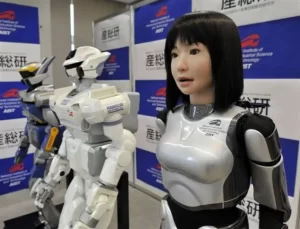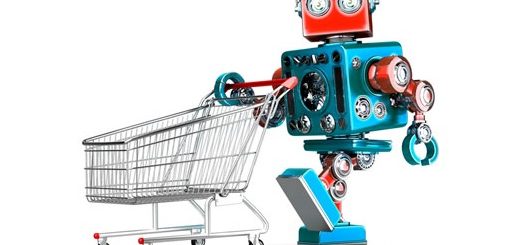Fun facts on the best android humanoid robots and Is Sophia the robot an android?
Android humanoid robots can be used in dangerous or harmful situations where human safety is at risk, such as bomb disposal, disaster relief, or deep-sea exploration. They can facilitate smoother interaction with people, especially in tasks requiring empathy and social skills.
Android humanoid robots
The term “android” specifically refers to a humanoid robot, meaning it resembles a human in appearance and behavior. The word “android” originated in science fiction, Androids are already being used in various fields, like healthcare (helping patients with rehabilitation or providing companionship) and education (engaging students in interactive learning experiences).
The majority of humanoid robots with distinct appearances tend to be female. This design choice is attributed to the perception that females are warmer, more approachable, and less threatening. Many well-known humanoid robots, like Sophia and Nadine, are designed with female appearances.
Sophia, a humanoid robot developed by Hanson Robotics, became the first robot to be granted citizenship by a country – Saudi Arabia in 2017. This sparked debates about the legal and ethical implications of artificial intelligence (AI) and robot rights.
Pepper, a humanoid robot developed by SoftBank Robotics, has been used in hospitals to help patients connect with loved ones virtually during the pandemic. While not designed for combat, some humanoid robots possess impressive strength and agility. Atlas, a robot developed by Boston Dynamics, can perform parkour flips and lift heavy objects.
While some humanoid robots can perform impressive feats like walking or running, their strength is limited compared to their human counterparts. Real-world androids are focused on tasks requiring dexterity, precision, and human-like interactions, such as assisting the elderly or performing delicate surgeries.
Some androids are incorporating motion capture technology to learn and replicate human movements, the future of androids is focused on cooperation and collaboration, assisting humans in various fields and tasks. Humanoid robotics is a constantly evolving field, with new advancements and discoveries happening all the time.
Advantages of Android Humanoid Robots
Their human-like form allows them to perform a wide range of tasks in various environments. They can navigate uneven terrain, manipulate objects with dexterity, and naturally interact with humans. This makes them suitable for tasks like household chores, search and rescue operations, and assembly lines.
Android Humanoid Robots can facilitate better interaction and acceptance by humans, This is beneficial for applications like customer service, education, and healthcare, where robots can assist therapists in rehabilitation sessions. They can provide companionship and assistance to the elderly, disabled, or those living in isolation.
They can perform a wide range of tasks, from complex industrial jobs to delicate healthcare applications. Their ability to mimic human appearance and movement can facilitate smoother interaction with people, making them suitable for companionship roles.
Android humanoid robots can safely handle dangerous tasks that would be risky for humans. They can be deployed in dangerous or harmful situations, such as bomb disposal, disaster relief, exploring radioactive zones or extreme environments, deep-sea exploration, or handling radioactive materials.
Humanoid robots can be used for training and simulation purposes. They can mimic real-world scenarios, allowing for safer and more realistic training experiences for various professions. They can use tools designed for humans, and interact with objects in the real world.
Humanoid robots can be used for simulations and training purposes, providing realistic scenarios for firefighters, soldiers, or medical professionals. Their advanced mechanics can enable them to handle objects and tools with high precision and flexibility, performing tasks requiring fine motor skills.
Disadvantages of Android Humanoid Robots
Despite advancements, they still face limitations in areas like mobility, balance, and perception. Their movements might not be as fluid as humans, and their ability to understand the world as effectively as humans and navigate complex environments can be hindered.
Building and maintaining sophisticated humanoid robots is expensive due to the complex engineering and advanced materials involved. This limits their widespread adoption, especially in areas where budget constraints are significant.
Their human-like appearance raises ethical concerns, particularly regarding their potential use in warfare or as replacements for human interaction. questions arise about their rights and responsibilities, as they become more sophisticated and autonomous.
Their movements might be stiff and unnatural, and their decision-making capabilities are still under development. where the resemblance is close enough to trigger a sense of eeriness or discomfort in humans. the need for clear regulations, and the possibility of misuse for malicious purposes.
Some people find the human-like appearance of androids unsettling, experiencing a phenomenon called the “uncanny valley”. This can hinder their acceptance and social integration. The long-term societal and economic impact of the widespread adoption of humanoid robots is still unclear, requiring careful consideration and ongoing discussions.
Current technology limits their movement fluidity, sensory perception, and overall intelligence compared to humans. The development and use of human-like robots raise ethical questions regarding artificial intelligence, consciousness, and potential misuse. Concerns exist about humanoid robots replacing human jobs in various industries, leading to unemployment and economic disruption.
You can follow Science Online on Youtube from this link: Science online
You can download the Science Online application on Google Play from this link: Science Online Apps on Google Play
Sophia robot review, features, use, advantages and disadvantages
Top trending topics on Sophia robots and Can Sophia Destroy humans
Educational robotics, Robot teachers, Social robots review, features advantages & drawbacks
Humanoid robots use, risks, advantages and disadvantages
Advantages and disadvantages of using robots in our life
Robot teachers use, advantages and disadvantages
Boston Dynamics Atlas review, advantages and features, How does Atlas robot work?
Pepper robot review, features and What can Pepper do for your business?




